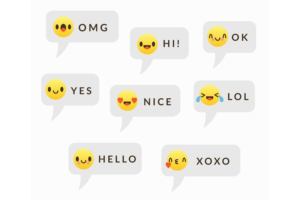
Source: Unsplash
In the last part on the evolution of emojis, you were able to delve deeper into the development process and historical background. Today it’s all about the evolution in terms of influencing our digital communication.
Fact Check

Source: Freepik
Quick fact check at the beginning. The difference between an emoji and an emoticon is that emoticons consist only of characters and emojis are an actual image/pictogram. There are now over 3,000 different ones and they look different depending on which operating system, font or chat platform is used.
With all the facts in hand, let’s now tackle the question: How much do emojis influence us? Can we imagine life without them today? And what is also very interesting is whether all ambiguities in the interpretation of chats have now been resolved? [1]
The Top Emojis
Not all emojis make it to the same places everywhere, depending on the country, for example. In Italy, the heart is particularly popular, whereas in Venezuela, folded hands are used the most. However, one emoji tops all others internationally: the tears and laughter smiley. In 2022, however, it faced competition from the opposite tears and wine smiley, which was triggered by the coronavirus pandemic. In general, however, positive emojis predominate. The most popular emojis in 2023 include the tears and laughter smiley, the red heart and the thumbs-up emoji.
Function and Advantages

Source: Freepik
Emojis replace words, express emotions and reinforce messages. [2] Emojis also help to better express emotions and irony in text, which is often difficult without facial expressions and gestures. They structure texts and draw attention. [3]
Challenges and Misunderstandings
However, emojis can also lead to misunderstandings, as some emojis are interpreted differently. A well-known example is the “sleepy face” emoji, which is often misinterpreted as sad. [2] Furthermore, emojis are not always universally understood and can have different meanings depending on the culture. For example, the face mask emoji in Germany often stands for hospitals, while in Asia it means protecting others from illness. [3]
Cultural Relevance and Further Development
Emojis reflect cultural norms and social changes. Annual updates ensure that they remain current and inclusive. The visual communication enabled by emojis adds an emotional and personal touch to our digital interactions, similar to historical symbols and pictograms. [2]
The Future of Emojis
Emojis enrich written language and help to make emotions visible. Their use is steadily increasing and the variety of available symbols is growing continuously. [3]
Responsible for the content of this article are Merrit Mielke and Hania Eid.
[1] https://www.wissen.de/world-emoji-day-die-geschichte-des-emojis





Great insights into how emojis shape our digital communication! Love the blend of history, cultural relevance, and their evolving impact.
Dear Simran,
Thank you for your comment and positive feedback!
Kind regards
the IT Center Blog Team